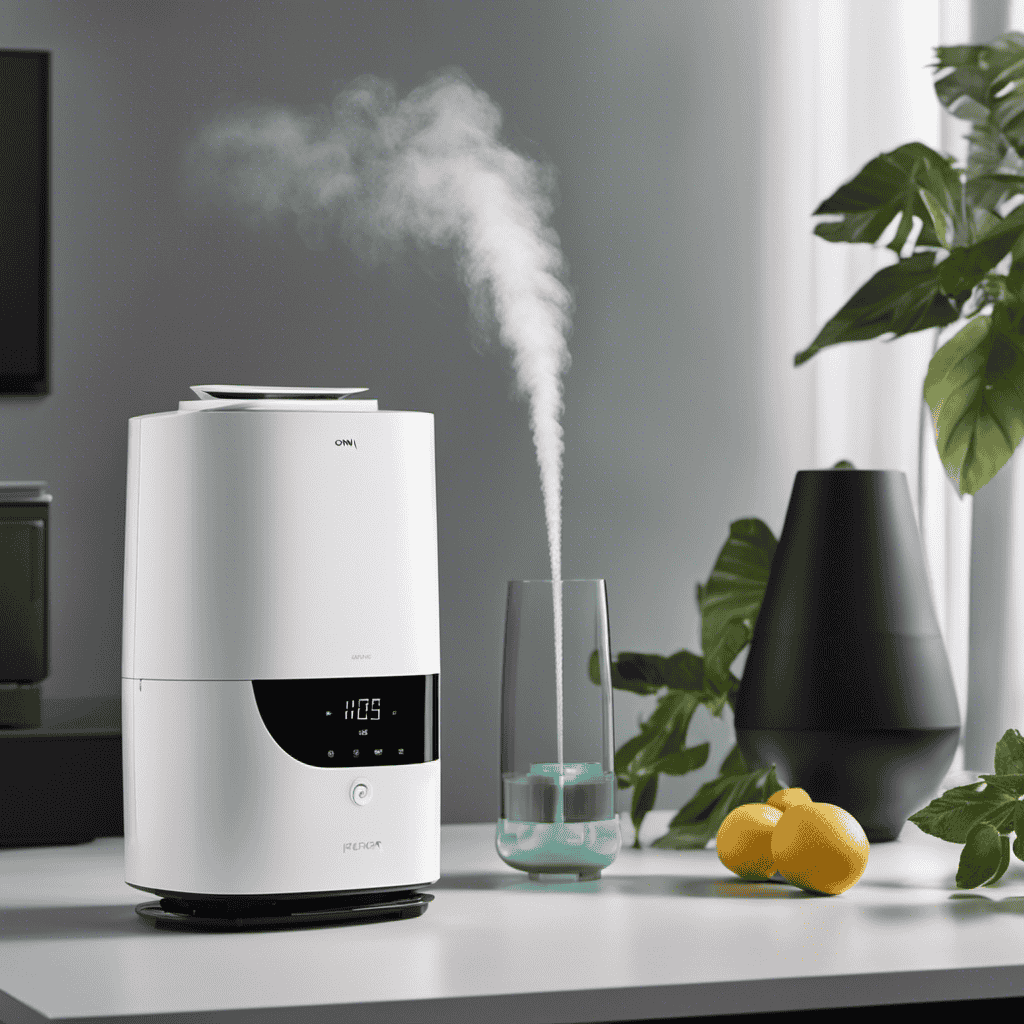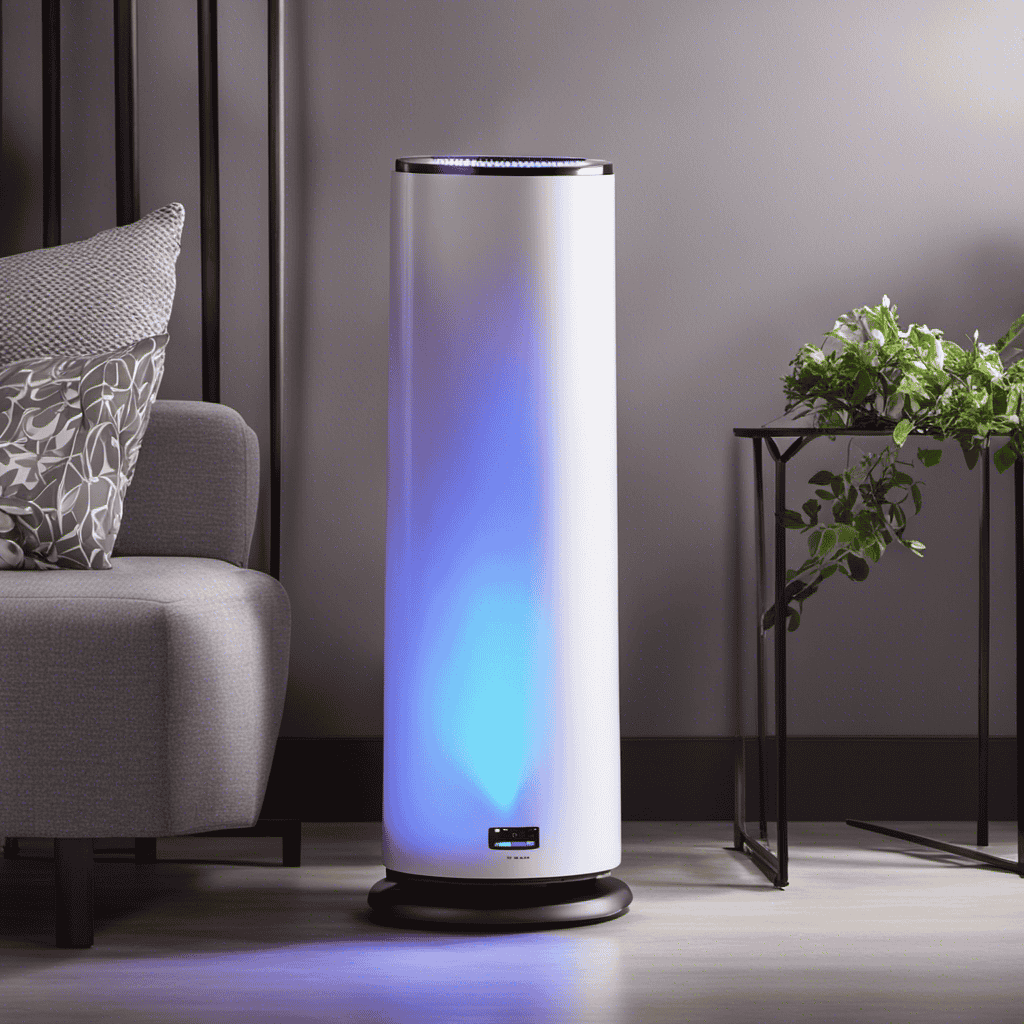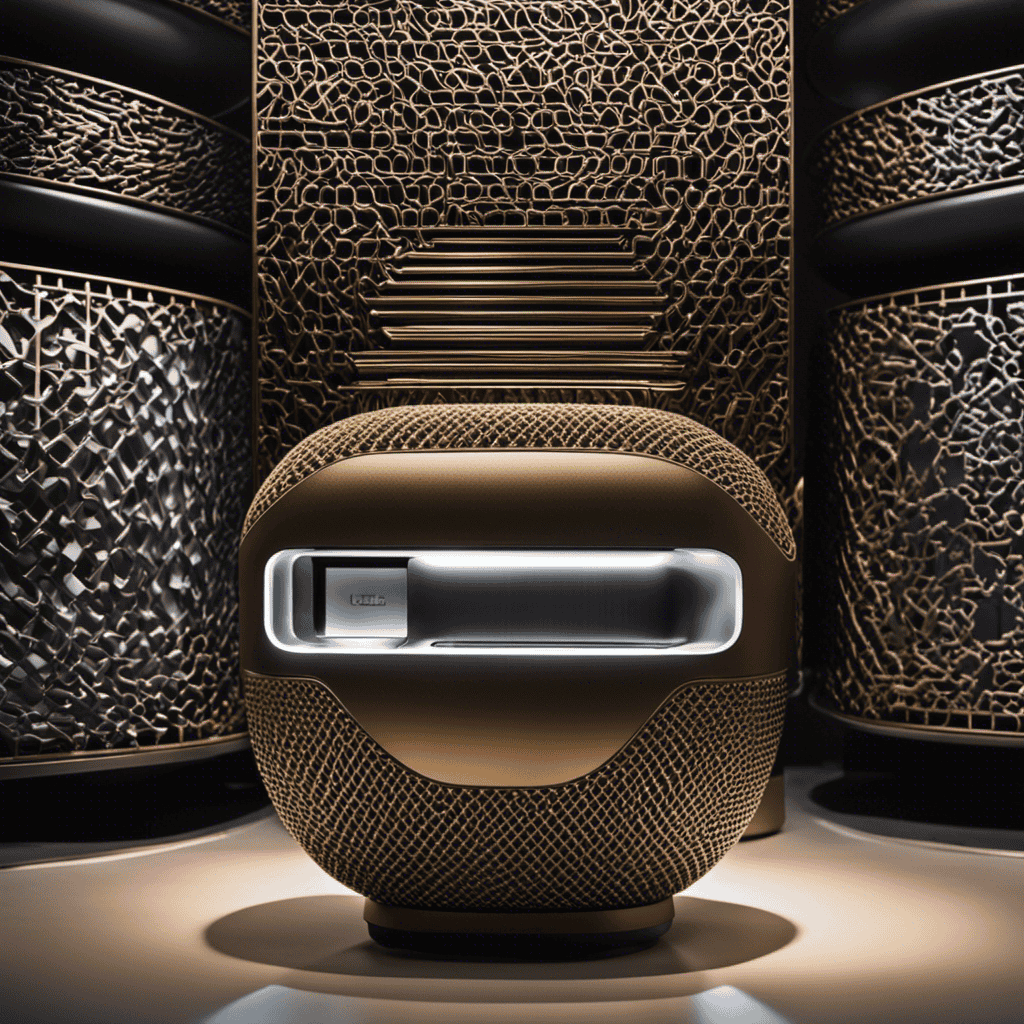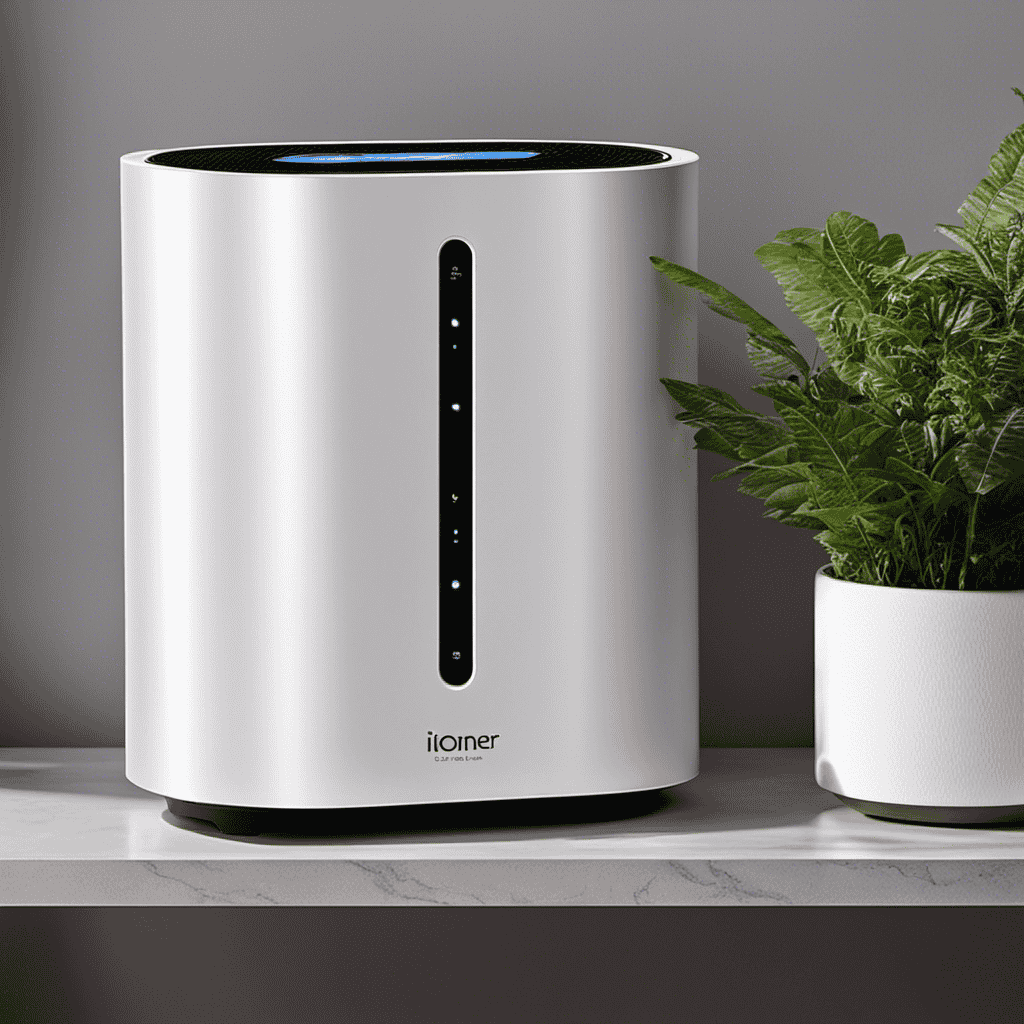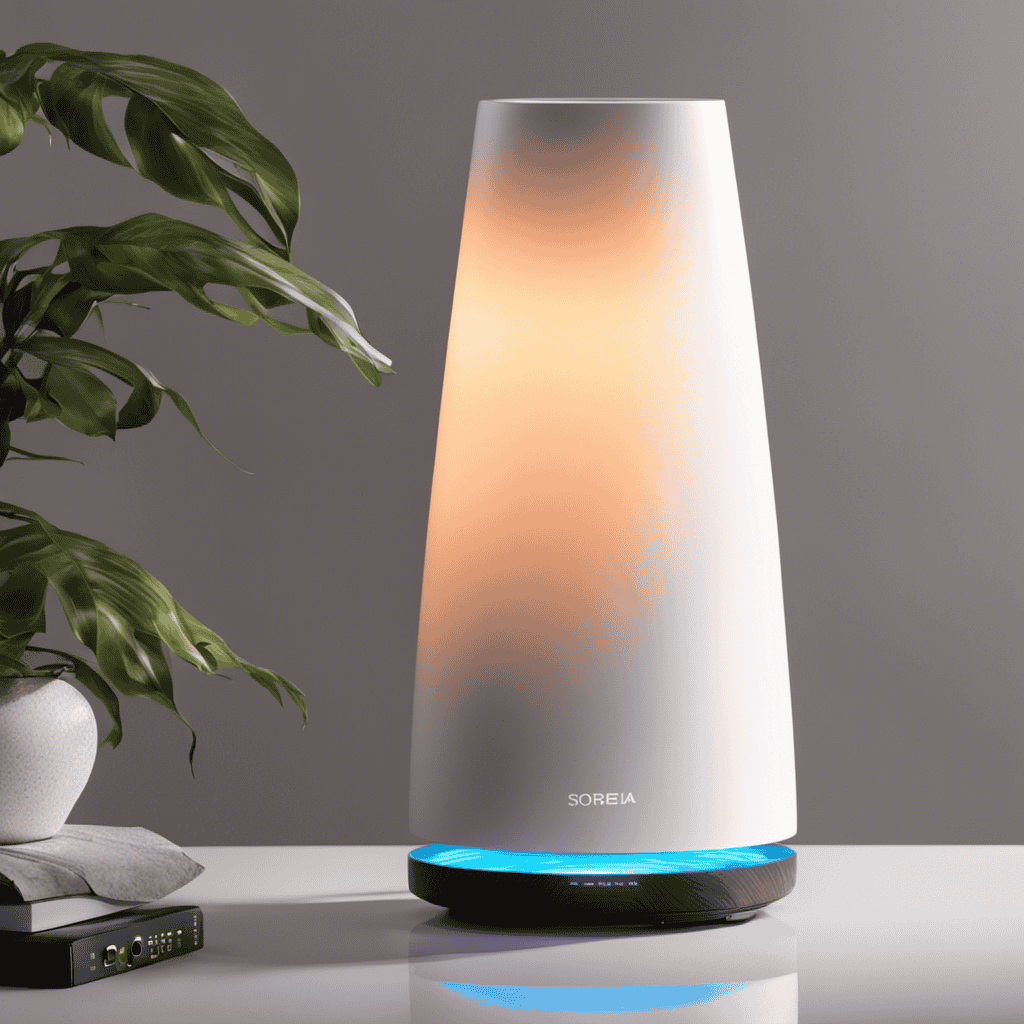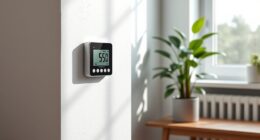There’s a well-known adage that sums it up perfectly: ‘knowledge is power.’ In the realm of air quality, grasping the distinctions between an air humidifier and an air purifier is crucial.
In this article, I’ll break down the functionality, benefits, operation, health impact, and how to choose the right device. So, if you’re looking to make an informed decision and create a healthier living environment, keep reading.
Key Takeaways
- Air purifiers focus on improving air quality by capturing particles like dust, pollen, pet dander, and mold spores.
- Air purifiers do not have the ability to control humidity levels.
- Air purifiers improve indoor air quality by removing pollutants and allergens.
- Air purifiers use filters or technologies like HEPA to effectively remove contaminants.
Functionality
If you’re looking for a device that can remove impurities from the air, an air purifier is what you need. Air purifiers are designed to improve air quality by trapping and eliminating airborne contaminants such as dust, pollen, pet dander, and mold spores. They work by pulling in the surrounding air and passing it through a series of filters that capture these particles.
The filters in air purifiers are specifically designed to remove even the smallest particles, ensuring cleaner air for you to breathe. While air purifiers focus on air quality improvement, they do not have the ability to control humidity levels.
For humidity control, you would need an air humidifier, which adds moisture to the air to combat dryness. Air purifiers and air humidifiers serve different purposes but can be used together to create a healthier indoor environment.
Benefits
One major benefit of using an air purifier is that it helps to remove pollutants and allergens from the air you breathe. This is crucial for maintaining good indoor air quality and promoting respiratory health.
Here are some key benefits of using an air purifier:
-
Reduces indoor air pollution: Air purifiers effectively capture and eliminate harmful particles such as dust, pollen, pet dander, and mold spores, improving the overall air quality in your home.
-
Alleviates allergy symptoms: By removing allergens from the air, air purifiers can significantly reduce allergy symptoms such as sneezing, coughing, and itchy eyes.
-
Removes harmful chemicals and odors: Air purifiers equipped with activated carbon filters can eliminate volatile organic compounds (VOCs), smoke, and unpleasant odors, creating a healthier and more pleasant living environment.
-
Enhances respiratory health: Clean air is essential for maintaining optimal respiratory health, especially for individuals with asthma or other respiratory conditions. Air purifiers help to reduce the risk of respiratory illnesses and promote better breathing.
Operation
To operate an air purifier, simply plug it in and turn it on.
Air purifiers are designed to improve indoor air quality by removing pollutants and allergens.
When it comes to operation efficiency, air purifiers are highly efficient in capturing and trapping airborne particles.
They use filters or technologies like HEPA (High-Efficiency Particulate Air) to effectively remove contaminants from the air.
Maintenance requirements for air purifiers are relatively low.
Regularly cleaning or replacing the filters is essential to ensure optimal performance.
Some models also have indicator lights that notify when it’s time for filter replacement.
Now, let’s delve into the health impact of air purifiers and how they can improve our overall well-being.
Health Impact
When using an air purifier, you may experience improved health and overall well-being due to the removal of pollutants and allergens from the air. This can have several health benefits and positive environmental impacts.
Improved respiratory health: Air purifiers can remove airborne particles such as dust, pollen, and pet dander, which can trigger allergies and asthma. By reducing these allergens, air purifiers can help alleviate symptoms and improve respiratory health.
Reduced risk of respiratory infections: Air purifiers can also help remove harmful bacteria and viruses from the air, reducing the risk of respiratory infections such as the common cold or flu. This can be especially beneficial for individuals with weakened immune systems or those living in densely populated areas.
Better sleep quality: Clean air can promote better sleep by reducing irritants that can disrupt sleep, such as dust and pet dander. By improving air quality, air purifiers can create a more conducive sleeping environment.
Positive environmental impact: Air purifiers can contribute to a cleaner and healthier environment by reducing the levels of air pollutants. This can help mitigate the negative effects of pollution on both human health and the planet.
Overall, using an air purifier can provide significant health benefits and contribute to a cleaner and healthier living environment.
Choosing the Right Device
Before purchasing an air purifier, it’s important to consider factors such as room size and specific air quality needs. When it comes to maintenance requirements, different air purifiers have varying needs. Some models require frequent filter replacements, while others have washable filters that can be reused. It’s crucial to check the manufacturer’s recommendations to ensure proper maintenance and optimal performance.
Energy consumption is another important aspect to consider. Air purifiers vary in their energy efficiency, and it’s essential to choose one that fits within your energy budget. Look for models with energy-saving features like programmable timers and sleep modes to reduce energy consumption when not in use.
Frequently Asked Questions
Can an Air Humidifier or Air Purifier Remove All Types of Allergens From the Air?
Yes, air purifiers can remove pet dander and dust mites from the air, reducing allergens. Additionally, using air humidifiers or purifiers can have potential health benefits by improving air quality and reducing respiratory issues.
Are Air Humidifiers or Air Purifiers Noisy When in Operation?
Air humidifiers and air purifiers have different functions. Humidifiers add moisture to the air, while purifiers remove pollutants. They vary in energy efficiency and ease of cleaning. Noise levels depend on the specific model.
Can Air Humidifiers or Air Purifiers Help With Respiratory Conditions Such as Asthma or Allergies?
Air purifiers can alleviate symptoms of respiratory conditions by removing allergens and pollutants from the air. However, air humidifiers are not as effective in reducing asthma triggers, as they primarily add moisture to the air.
How Often Should the Filters in Air Humidifiers or Air Purifiers Be Replaced?
When it comes to replacing filters in air humidifiers or air purifiers, it’s crucial to choose the right one. Regular maintenance and cleaning are essential for optimal performance. Here are some tips to keep your air quality in check.
Do Air Humidifiers or Air Purifiers Consume a Lot of Electricity?
Air purifiers consume more electricity due to the use of fans and filters, but they have a significant impact on improving indoor air quality. On the other hand, air humidifiers are more energy-efficient and focus solely on increasing humidity levels.
How Does an Air Diffuser Differ from an Air Humidifier in terms of Air Quality Improvement?
An air diffuser disperses essential oils into the air to create a pleasant aroma, while an air humidifier adds moisture to the air. Both can improve air quality, but the difference between air purifier and air diffuser lies in their function – one purifies the air, while the other adds fragrance.
Conclusion
In conclusion, understanding the difference between an air humidifier and an air purifier is crucial when it comes to improving indoor air quality.
While both devices have distinct functions, an air purifier focuses on removing contaminants from the air, while an air humidifier adds moisture to combat dryness.
Interestingly, studies have shown that indoor air can be up to five times more polluted than outdoor air, highlighting the importance of investing in the right device to maintain a healthy living environment.
